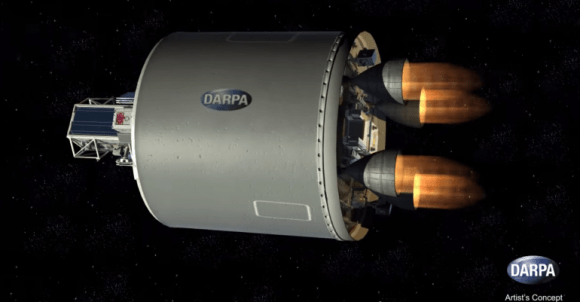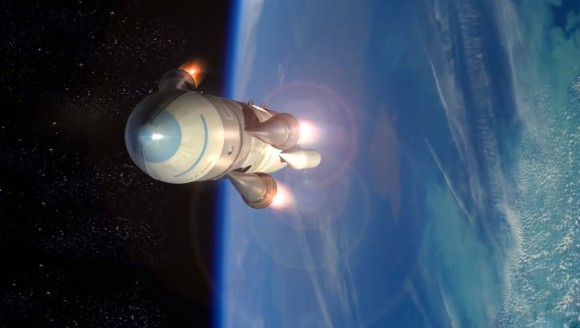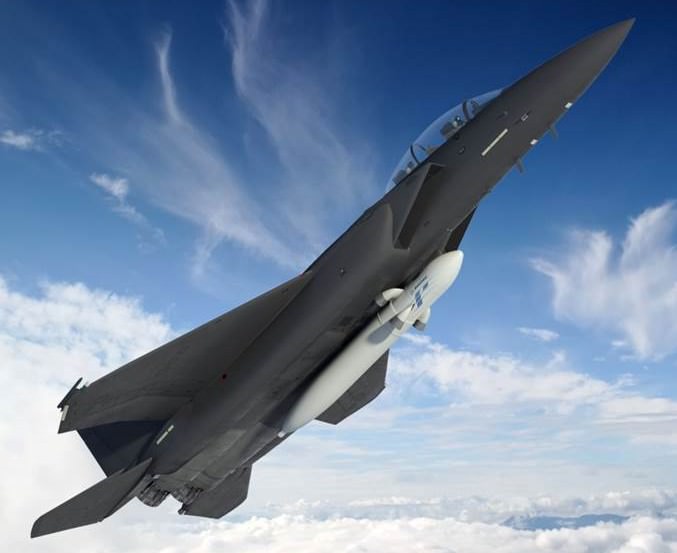For decades, the human race has been deploying satellites into orbit. And in all that time, the method has remained the same – a satellite is placed aboard a booster rocket which is then launched from a limited number of fixed ground facilities with limited slots available. This process not only requires a month or more of preparation, it requires years of planning and costs upwards of millions of dollars.
On top of all that, fixed launch sites are limited in terms of the timing and direction of orbits they can establish, and launches can be delayed by things as simple as bad weather. As such, DARPA has been working towards a new method of satellite deployment, one which eliminates rockets altogether. It’s known as the Airborne Launch Assist Space Access (ALASA), a concept which could turn any airstrip into a spaceport and significantly reduce the cost of deploying satellites.
What ALASA comes down to is a cheap, expendable dispatch launch vehicle that can be mounted onto the underside of an aircraft, flown to a high altitude, and then launched from the craft into low earth orbit. By using the aircraft as a first-stage, satellite deployment will not only become much cheaper, but much more flexible.
DARPA’s aim in creating ALASA was to ensure a three-fold decrease in launch costs, but also to create a system that could carry payloads of up to 45 kg (100 lbs) into orbit with as little as 24 hours’ notice. Currently, small satellite payloads cost roughly $66,000 a kilogram ($30,000 per pound) to launch, and payloads often must share a launcher. ALASA seeks to bring that down to a total of $1 million per launch, and to ensure that satellites can be deployed more precisely.

News of the agency’s progress towards this was made at the 18th Annual Commercial Space Transportation Conference (Feb 4th and 5th) in Washington, DC. Bradford Tousley, the director of DARPA’s Tactical Technology Office, reported on the progress of the agency’s program, claiming that they had successfully completed phase one, which resulted in three viable system designs.
Phase two – which began in March of 2014 when DARPA awarded Boeing the prime contract for development – will consist of DARPA incorporating commercial-grade avionics and advanced composites into the design. Once this is complete, it will involve launch tests that will gauge the launch vehicle’s ability to deploy satellites to desired locations.
“We’ve made good progress so far toward ALASA’s ambitious goal of propelling 100-pound satellites into low earth orbit (LEO) within 24 hours of call-up, all for less than $1 million per launch,” said Tousley in an official statement. “We’re moving ahead with rigorous testing of new technologies that we hope one day could enable revolutionary satellite launch systems that provide more affordable, routine and reliable access to space.”
These technologies include the use of a high-energy monopropellant, where fuel and oxidizer are combined into a single liquid. This technology, which is still largely experimental, will also cut the costs associated with satellite launches by both simplifying engine design and reducing the cost of engine manufacture and operation.

Also, the ability to launch satellites from runways instead of fixed launch sites presents all kinds of advantages. At present, the Department of Defense (DoD) and other government agencies require scheduling years in advance because the number of slots and locations are very limited. This slow, expensive process is causing a bottleneck when it comes to deploying essential space assets, and is also inhibiting the pace of scientific research and commercial interests in space.
“ALASA seeks to overcome the limitations of current launch systems by streamlining design and manufacturing and leveraging the flexibility and re-usability of an air-launched system,” said Mitchell Burnside Clapp, DARPA program manager for ALASA. “We envision an alternative to ride-sharing for satellites that enables satellite owners to launch payloads from any location into orbits of their choosing, on schedules of their choosing, on a launch vehicle designed specifically for small payloads.”
The program began in earnest in 2011, with the agency conducting initial trade studies and market/business case analysis. In November of that same year, development began with both system designs and the development of the engine and propellant technologies. Phase 2 is planned to last late into 2015, with the agency conducting tests of both the vehicle and the monopropellant.
Pending a successful run, the program plan includes 12 orbital launches to test the integrated ALASA prototype system – which is slated to take place in the first half of 2016. Depending on test results, the program would conduct up to 11 further demonstration launches through the summer of 2016. If all goes as planned, ALASA would provide convenient, cost-effective launch capabilities for the growing government and commercial markets for small satellites, which are currently the fastest-growing segment of the space launch industry.
And be sure to check out this concept video of the ALASA, courtesy of DARPA:
Further Reading: DARPA TTO, DARPA News


So, it’s only taken DARPA 30-some years to figure out that there might be an alternate application for the old F-15-launched ASAT system? Hmmmm…
http://en.wikipedia.org/wiki/Anti-satellite_weapon#mediaviewer/File:ASAT_missile_launch.jpg
The idea has actually been around since the 1950s, but technical (and presumably cost) difficulties held it back. The method was first used successfully in 1990 (5 years after that photo you posted), but it required a dedicated plane, whereas this project aims to use a regular fighter jet with little in the way of specialised hardware.
Not saying the idea isn’t an old one; it can be argued (easily, I think) that the whole X- program of the ’50s & ’60s was just this idea in a manned form, with the eventual goal of taking off from a runway to go SSTO with a manned craft. All I’m saying is that the USAF did this in the ’80s: launch a not-insignificant payload into a specific spot in LEO at a specific time from a fighter plane. To my mind, it shouldn’t have been so hard to convert from explosive to non/semi-explosive payloads that it took three whole decades for DARPA to figure it out.
In fact come to think of it, THEY really didn’t have to: Northrop-Grumman (in its separate, and then joined forms, and among others) was designing stuff like this to launch off of F-14s and -15s back around the early ’90s. Maybe DARPA just finally decided it was time to do something other than wait for the next Space Shuttle to come along.
Energetically, there is a big difference between launching to intersect something in LEO, and actually launching into LEO yourself. The former is just a suborbital flight, which you can do with small fraction of the deltaV required to enter orbit.
That’s true, of course. In the end it’s about momentum: (the smaller your satellite) x (the more efficient* your motor) = the easier orbit becomes. That said, the air-launched LEO delivery systems I mention existed in plans & prototypes a quarter-century ago. Only thing is that while DARPA actually funded a fair amount of the development, it never bought any of the finished products.
I should add, “Until now, apparently.” =)
*(By “efficient,” I mean power vs. weight. A bottle rocket doesn’t weigh much & the Saturn V is powerful, but neither is “efficient” for the purpose at hand.)
No, it only took DARPA a short time to copy Burt Rutan’s White Knight/Space ship 1 concept. 8)
To be fair, it wasn’t Rutan’s originally, either. The USAF’s X-program (Chuck Yeager, the Bell X-1, etc.) was prior with the goal of attaining LEO, and the idea itself even predates that time. Their plan launched rockets from a ‘lifter’ (in the USAF’s case, a B-52) to get flight data to figure out what was going on at those speeds/altitudes. Then they stepped it up, Mythbusters’ style, adding a higher-powered manned version of that rocket (X-1 through -15) to go higher & faster and see what happened.
Eventually they hoped to gather enough data on flight dynamics, propulsion systems & fuel mixtures, etc., that they could scale things to the point of launching a sub-orbital cruiser (e.g., Spaceship 2) from the lifter (a la Galactic’s White Knight), followed in turn by an orbital one, either of which would return to earth via controlled flight/glide to land wheels-down on a runway. The ‘Holy Grail’ was to combine both craft into a single one able to fly to LEO from a runway take-off, and then land wheels-down on the same (or any other suitable) runway — Single Stage To Orbit (SSTO).
Sadly, JFK’s ICBM Development Initiative (composed of the “Mercury,” “Gemini” & “Apollo” stages*) and the onset of the Vietnam conflict put the X-program so far down on the budget list that it never went sub-orbital before cancellation, despite clear data indicating that a sub-orbital mission was A) within then-current technological reach, and B) a WHOLE LOT SAFER than strapping people to the tops of ballistic missiles, and then subjecting them to an uncontrolled, multi-G fire-ball re-entry. In a way, then, one could argue that that “small step for (a) man” is precisely why we STILL don’t have 2hr (gate to gate) suborbital flights from London to Tokyo, or Sydney to Rome, and so forth.
Those forced to endure 12hr+ international flights may now collectively point the finger at our JFK. (^_~)
*(Not saying valuable, worth-doing science wasn’t done, just saying that the US was able to leap-frog the world in nuclear weapons delivery, tracking & targeting technology, and NO ONE SAID A WORD — presumably because it was all for “science,” and “peace,” and “humanity,” etc. Or maybe they just weren’t willing to risk a nuclear WWIII over it. Could’ve been that.)
Ok, but launching a rocket from a jet is also military. The Avro ‘Blue Steel’ rocket started in the 1950’s is an example…
https://www.youtube.com/watch?v=FwMnEoC0gVg
If you keep playing, you get some lovely old newsreel material. We were all within an ace of getting nuked back then, but somehow everything seemed a lot more hopeful. Doubtless the US had an even earlier version, but I don’t know of it.
As for the atmosphere skipping aircraft, these are all descended from Dr. Eugen Sänger’s ‘Silver bird’ or the ‘Amerika Bomber’ mooted in the 1930’s…
http://greyfalcon.us/Sanger.htm
If you want something that is non-military, then you will have trouble. Even the horse got to its present size in Norman times because of a weapons program. You either deal with it, or you try and explore the outer planets using solar cells like the Philae lander did, and run out of power when the Pioneer probes are still going.
You’re not aware that the G forces on Alan Shepard’s sub orbital flight was much higher than Apollo or Space Shuttle G forces on re-entry?
Sub orbital hits the atmosphere at a more direct angle such that the denser atmosphere is encountered sooner resulting in high G forces. And trans continental flights are fire ball re-entries.
“Currently, small satellite payloads cost roughly $66,000 a kilogram ($30,000 per pound) to launch, and payloads often must share a launcher.”
It’s really more of an either/or. Either you pay through the nose for a very small launcher, or you share a rocket with much more affordable cost/kg.
“These technologies include the use of a high-energy monopropellant, where fuel and oxidizer are combined into a single liquid.”
I would love to know what they are considering. The current monopropellent of choice, hydrazine, is actually pretty crappy.
A fighter jet reaches about a fifth of orbital speed (right?) Seems little helpful, considering the constraints on the launching rockets and payload. Maybe it offers a useful flexibility for a short lived military satellite. But this concept won’t help any real space flight application.
As with the air-launch of the small pegasus rocket, I believe the advantage has less to do with the starting velocity and more to do with starting altitude. Surface area / volume ratio means that air resistance is a much bigger deal for small rockets than for big ones, so “launching” from above 3/4 of the earth’s atmosphere lets you make orbit with a much smaller rocket. For large rockets, air launch is much more of a pain and the advantage is negligible.
The Shuttle itself was originally designed to be lifted on the back of a 747 for precisely this reason. Even for big rockets, aerodynamic resistance can be a real drag, hehe.
Of course, it never worked that way due to the technical issues involved in carrying their fuel AND their cargo simultaneously, thus the ICMB/fuel tank work-around strapped to the belly. But even the work-around required a work-around: immediately after lift-off the Shuttle had to throttle back in order to avoid ripping itself apart due to the thickness of the atmosphere at low altitude.
“A fighter jet reaches about a fifth of orbital speed (right?)”
Not quite. Other than (allegedly, unofficially, according to a few unconfirmed reports) the SR-71, nothing manned & air-breathing goes over about Mach 3, let alone the Mach 5-6 which would equal 1/5 orbital velocity of most things in Earth orbit.(*) As E pointed out, though, speed isn’t the primary benefit of an aerial launch platform.
*(You can use a site like http://hyperphysics.phy-astr.gsu.edu/hbase/orbv3.html to figure out the speed of objects in circular terrestrial orbits relative to the ground. Note that it will NOT tell you how much energy you had to use to put them there in the first place; the Moon, for instance, only has an orb.v = ~2300mph — a speed some military jets can match!)
I doubt that benefit is of importance. Conventional rockets have low speed through the thickest part of the atmosphere. I don’t think they travel faster than a fighter jet at the altitude a fighter jet can operate at. Airlaunch might have some very particular advantages as in flexibility, but I don’t see how that concept could lift space flight.
You are right that rockets, large or small, don’t move through the troposphere much faster than a supersonic fighter jet. But it is a mistake to conclude from this that there is no significant cost or efficiency advantage, particularly for small rockets, to air launch. A fighter jet, and a first stage capable of carrying the rocket to an equivalent speed and altitude, both experience air resistance, but the fighter jet is re-usable while the first stage is not. Additionally it is easy to underestimate just how much extra rocket you would need for that part of the flight, because jet engines are vastly more efficient than rocket engines (specific impulse in the thousands vs. 300-400 for a rocket engine). So particularly when they have a widely used airframe on hand, already equipped to carry and deploy heavy payloads, this seems like a pretty good idea.
Sad to say but mankind finds an new toy and immediately wants to know how efficacious will be to kill people with it.
Logically, it’s equally true to say “mankind finds a new weapon and immediately wants to know how it can be repurposed to make life better for everyone on the planet.” I generally prefer the glass half full, myself. 🙂